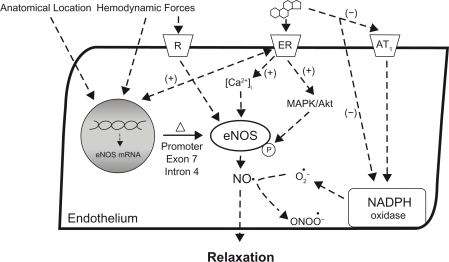Figures & data
Figure 1 Factors affecting NO-mediated endothelium-dependent relaxation of coronary arteries in hypertension. Chemical and hemodynamic forces on the luminal side of the endothelium stimulate eNOS production of NO which can be scavenged by superoxide or diffuse to the vascular smooth muscle cells. At the smooth muscle, available NO activates sGC ultimately affecting Ca2+ regulatory proteins, cytosolic [Ca2+], and contractile elements, thereby causing arterial relaxation. In hypertension, NO-bioavailability and relaxation of the coronary vascular smooth muscle can be altered due to many factors as discussed in the text and indicated in the Figure by the small arrows.
![Figure 1 Factors affecting NO-mediated endothelium-dependent relaxation of coronary arteries in hypertension. Chemical and hemodynamic forces on the luminal side of the endothelium stimulate eNOS production of NO which can be scavenged by superoxide or diffuse to the vascular smooth muscle cells. At the smooth muscle, available NO activates sGC ultimately affecting Ca2+ regulatory proteins, cytosolic [Ca2+], and contractile elements, thereby causing arterial relaxation. In hypertension, NO-bioavailability and relaxation of the coronary vascular smooth muscle can be altered due to many factors as discussed in the text and indicated in the Figure by the small arrows.](/cms/asset/0dd2e1ef-f332-4263-be9c-e6f38d31ed08/dvhr_a_7464_f0001_b.jpg)
Figure 2 Effects of genetic factors and estrogen on eNOS function and NO bioavailability in coronary arteries with hypertension. Activation of the membrane-bound estrogen receptor can increase eNOS expression and activation as well as reduce the destruction of NO by superoxide, thereby increasing NO available for relaxation. Local hemodynamics, location in the coronary vascular bed, and genetic polymorphisms can also affect eNOS expression and may impact coronary relaxation in hypertension.
